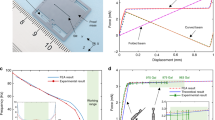Abstract
Seafloor deformation or displacement in methane hydrate production areas is a significant environmental problem that can cause considerable damage. This paper describes a conceptual design for monitoring seafloor deformation that differs from existing monitoring methods that include acoustic and pressure sensors, which have high costs and are only suitable for detecting vertical deformation. The proposed monitoring system is vertically mounted in each monitoring well to detect the displacement of submarine soil layers at different depths and to provide visual feedback by displaying three-dimensional images in real time. To reduce the drift error and to obtain more reliable angle estimates, a Kalman filter algorithm is used to combine the data that are measured using a gyroscope and a digital compass. The stability and accuracy of the system are tested both in real-time test and off-line experiment, and the total errors of the azimuth and tilt angle are less than 0.03° and 0.19° in the static off-line experiment, respectively.













Similar content being viewed by others
References
Ellis S, Pecher I, Kukowski N, Xu W, Henrys S, Greinert J (2010) Testing proposed mechanisms for seafloor weakening at the top of gas hydrate stability on an uplifted submarine ridge (rock garden), New Zealand. Mar Geol 272(1):127–140
Xu W, Germanovich LN (2006) Excess pore pressure resulting from methane hydrate dissociation in marine sediments: a theoretical approach. J Geophys Res Atmos 111(B1):B02104
Xu P, Ando M, Tadokoro K (2005) Precise, three-dimensional seafloor geodetic deformation measurements using difference techniques. Earth Planets Sp 57(9):795–808
Chadwell CD, Hildebrand JA, Spiess FN, Morton JL, Normark WR, Reiss CA (1999) No spreading across the southern Juan de Fuca ridge axial cleft during 1994–1996. Geophys Res Lett 26(16):2525–2528
Fujiwara T, Masaki Y, Yamamoto F (2015) Evaluation of spatial resolution and estimation error of seafloor displacement observation from vessel-based bathymetric survey by use of AUV-based bathymetric data. Mar Geophys Res 36(1):45–60
Gagnon K, Chadwell CD, Norabuena E (2005) Measuring the onset of locking in the Peru–Chile trench with GPS and acoustic measurements. Nature 434(7030):205–208
Kido M, Fujimoto H, Miura S, Osada Y, Tsuka K, Tabei T (2006) Seafloor displacement at Kumano-nada caused by the 2004 off Kii Peninsula earthquake, detected through repeated GPS/acoustic surveys. Earth Planets Sp 58(7):911–915
David CC, Spiess FN (2008) Plate motion at the ridge-transform boundary of the south cleft segment of the juan de fuca ridge from gps-acoustic data. J Geophys Res Solid Earth 113(B4):540–549
Yokota Y, Ishikawa T, Sato M, Watanabe S, Saito H, Ujihara N et al (2015) Heterogeneous interplate coupling along the Nankai trough, japan, detected by gps-acoustic seafloor geodetic observation. Prog Earth Planet Sci 2(1):1–12
Awashima Y et al (2008) Development of monitoring system on methane hydrate production. Oceans IEEE 2008:1–7
Saito H, Yokoyama T (2008) Development of seafloor displacement monitoring system using a 3-component servo-accelerometer. Oceans IEEE Xplor 2008:1–4
Yokoyama T, Shimoyama M et al (2012) Monitoring system of seafloor subsidence for methane hydrate production test. In: The 18th formation evaluation symposium of Japan, Sep 27–28, 2012, Chiba, Japan
Rutqvist J, Moridis GJ, Grover T, Silpngarmlert S, Collett TS, Holdich SA (2012) Coupled multiphase fluid flow and wellbore stability analysis associated with gas production from oceanic hydrate-bearing sediments. J Petroleum Sci Eng 92–93(4):65–81
InvenSense Inc (2012) MPU-9150 Product Specification Revision 4.0. http://strawberry-linux.com/pub/PS-MPU-9150A.pdf.5/14/2012
Yan-Jiang YU, Zhang ZG, Xing XU, Luo XH (2010) Design of the compressive instrument cabin used in deep sea. Ocean Technol 29(2):33–35
Konno Y, Fujii T, Sato A, Akamine K, Naiki M, Masuda Y, Yamamoto K, Nagao J (2017) Key findings of the world’s first offshore methane hydrate production test off the coast of Japan: toward future commercial production. Energy Fuels 31(3):2607–2616
Qin YY (2006) Inertial navigation. Science Press, Beijing
Caruso MJ (2000) Applications of magnetic sensors for low cost compass systems. In: Position location and navigation symposium IEEE, pp 177–184
Mohamed AH, Schwarz KP (1999) Adaptive kalman filtering for ins/gps. J Geodesy 73(4):193–203
Wang J, Stewart MP, Tsakiri M (2000) Adaptive Kalman filtering for integration of GPS with GLONASS and INS. In: Schwarz KP (ed) Geodesy Beyond 2000. International Association of Geodesy Symposia, vol 121. Springer, Berlin, Heidelberg
Kaniewski P, Kazubek J (2009) Integrated system for heading determination. Acta Phys Polonica 116(3):325
Brown RG, Hwang PYC (1997) Introduction to random signals and applied Kalman filtering. Wiley, New York
Acknowledgements
This research was funded by the Heritage Conservation Technological Project of Zhejiang Province Bureau of Cultural Relics (Grant no. 2016010). The authors would like to express appreciation to Minhao Zhang, Yifei Chen and Chunying Xu from the Institute of Marine Information Engineering of Zhejiang University for their helpful comments on the manuscript and English corrections. In addition, the authors express their sincere gratitude to the editor and anonymous reviewers for their valuable comments and suggestions.
Author information
Authors and Affiliations
Corresponding author
About this article
Cite this article
Wang, J., Han, J., Jing, D. et al. MEMS-based strata deformation monitoring system for methane hydrate production areas: a conceptual design. J Mar Sci Technol 23, 425–434 (2018). https://doi.org/10.1007/s00773-017-0476-4
Received:
Accepted:
Published:
Issue Date:
DOI: https://doi.org/10.1007/s00773-017-0476-4




